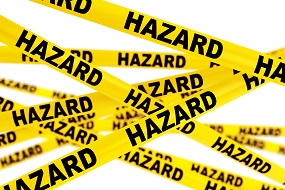Cut Your Workers’ Compensation Insurance Costs by Addressing Common Safety Hazards
 According to the National Safety Council (NSC), nearly 13,000 American workers are injured on the job every day. That’s about one every 7 seconds. Part of the NSC’s job is to send a team of consultants around the country to visit worksites and conduct safety audits. And no matter where they go, they see many of the same common safety hazards.
According to the National Safety Council (NSC), nearly 13,000 American workers are injured on the job every day. That’s about one every 7 seconds. Part of the NSC’s job is to send a team of consultants around the country to visit worksites and conduct safety audits. And no matter where they go, they see many of the same common safety hazards.
Those hazards are causing accidents and injuries – and many of those injuries are resulting in costly workers’ compensation claims. Here in California, you pay some of the highest workers’ compensation costs in the nation, so you have plenty of reasons to cut those costs every chance you get.
Workplace safety is your first line of defense against rising workers’ compensation costs.
The most obvious way to cut down on workers’ compensation claims is to improve safety and cut down on accidents and injuries. But there are many companies that merely record accidents and conduct safety training, but don’t really know why those accidents happen or how to prevent them.
Step one is taking time to thoroughly identify the most common safety hazards in your workplace. NSC consultants regularly see these seven common hazards. Are yours on the list?
- Working at height. Bureau of Labor Statistics (BLS) data shows that falls to a lower level accounted for 14 percent of all fatalities in 2014, and violations relating to ladders and scaffolding are among the most frequently cited OSHA violations.
- Poor housekeeping. Leaks, standing water, and clutter around aisles, stairways, and emergency exits can present trip and fall hazards.
- Electrical / extension cords. Blocked breakers and inappropriate use of extension cords are common, and they can be serious fire hazards.
- Forklifts. With pressure to keep production schedules on track, forklift drivers often feel compelled to work quickly, taking shortcuts or trying to lift too heavy a load.
- Lockout/tagout. Proper lockout/tagout procedures can prevent serious injuries, but only if those procedures are followed. Complacency, unfamiliarity with equipment, and being in a hurry are the most common violations.
- Confined spaces. Confined spaces present a variety of hazards. Failure to carry out a risk assessment is the most common cause of injury.
- Chemicals. If your company uses chemicals, make sure you have a control system in place. OSHA’s Hazard Communication Standard requires you to keep an inventory. Chemicals can become unstable when sitting over a long period of time, so it’s crucial to document what you have, purchase and expiration dates, etc.
Be laser-focused on prevention
Preventing accidents requires creating a culture of safety in your organization. How do you do that? By focusing on the things most likely to raise awareness about safety among your workers:
- Regular training. Thoroughly train your employees on safety protocols and the hazards associated with your workplace and their specific positions. Training begins at hire and should be regularly reinforced, with adequate regular monitoring and supervision to make sure employees are following proper safety procedures.
- Personal protective equipment. Make proper gear available to your workers, properly train them in its use and care, and require and enforce its use.
- Resources. Don’t use a lack of money or resources as an excuse for lax safety training in your company. Reach out to organizations such as OSHA, the NSC, and your insurance carrier for information and resources to bolster your workplace safety efforts.
Does your California workers’ compensation insurance partner help you proactively prevent accidents? Republic Capital is committed to helping you stop losses before they occur with programs including on-site training and access to a network of safety professionals. Want more ways to keep your workers’ compensation claim costs under control? Download our free report, “How Much Could You Save by Self-Insuring Your Work Comp?”
